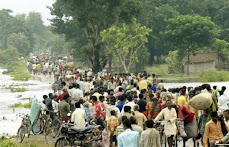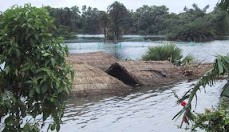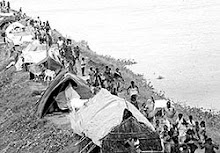After Tamil Nadu, Madhya Pradesh and Uttar Pradesh, Bihar too is initiating the misplaced project of linking rivers even as it is being predicted that "Ganga would soon become a seasonal river-flooded in monsoons and dry in the summers."
Out of the 30 links in the National Interlinking of Rivers project that includes 14 links in the Himalayan component, 6 river-link canals are directly related to Bihar. It is noteworthy that quite like Tamil Nadu, Bihar too is proposing its linking of rivers projects as independent of the national project.
States like Kerala, West Bengal and Punjab have rejected such projects. Neighboring countries Nepal and Bangladesh too has rejected Interlinking of Rivers projects in the past.
Unmindful of the global ecological changes and river basin approach Uttar Pradesh has already launched Ganga Expressway Project in 2007 to construct a 1047 km access controlled eight-laned expressway running along the Ganga river to provide connectivity and as a flood control measure although the catastrophe brought about by such measures is quite evident.
Continuing the same trend, Bijendra Prasad Yadav, Bihar's Water Resources Development Minister informed the Bihar Legislative Council on 4, December that inter-linking of rivers could rid the state of perennial problems of flood and drought. Replying to a special debate on drought like situation prevailing in many districts of south Bihar, Yadav said "unless and until rivers are inter-linked the twin problems can not be solved." Yadav said the inter-linking of Bihar rivers would cost more than Rs 4,000 crore.
Stating that 26 percent area of the state are drought-hit, Yadav informed the Vidhan Parishad that the state did not have any reservoir which was crucial for irrigation. It was either in Nepal or in Uttar Pradesh.
Replying to a debate on perennial problem of flood in the state referred to the devastation caused by the Kosi deluge and the probe by judicial commission underway.
Nearly 33.55 lakh people in five districts of north Bihar were affected by the devastation caused by the Kosi deluge due to the breach in the embankment at Kusaha in Nepal on August 18.
The Centre has constituted a high level committee, consisting of three representatives of the Centre, two from Nepal and five from Bihar government, for the repair and maintenance of the embankment.
He said the state did not have any reservoir which was crucial for irrigation. It was either in Nepal or in Uttar Pradesh.
He informed the House that about 33.55 lakh people in five districts were affected by the Kosi deluge.
Earlier, on 25 November, 2008 the Supreme Court sought a detailed status report from the government on the implementation of five river-linking projects in southern, western and central India.
A bench headed by Chief Justice K.G. Balakrishnan asked the central government to apprise it of the latest developments on the projects by the fourth week of January.
The bench, which also included Justice P. Sathasivam and Justice J.M. Panchal, also asked Maharashtra and Gujarat to apprise the court of the reasons for the delay in signing a treaty between the two states for interlinking the Par, Tapti, Narmada, Daman Ganga and Pinjal rivers.
The bench also asked Tamil Nadu and Kerala to apprise the court of their differences in linking three rivers - Pamba, Achankoli and Vaippar - in their regions.
The apex court is seized of the issue since the very inception of the concept by erstwhile National Democratic Alliance (NDA) government in 2000.
Supreme Court had taken cognizance of the issue on its own and has been monitoring the implementation of the project since then.
It had been seeking status reports from the central government and various government agencies besides the state governments on river-linking and issuing directions to them to expedite the project.
The bench sought to examine the progress in implementing the five projects.
Besides examining the projects in Maharashtra, Gujarat, Tamil Nadu and Kerala, the other projects that the court sought to examine include those of interlinking the Ken and Betwa rivers in Madhya Pradesh.
The court also examined the progress in linking the Parbati, Kali Sindhu and Chambal rivers in Madhya Pradesh and Rajasthan.
The fifth project that the court sought to examine related to the interlinking of the Godavari and Krishna rivers involving Orissa, Chhattisgarh, Andhra Pradesh, Maharashtra, Karnataka, Kerala, Tamil Nadu and Puducherry.
A workshop was inaugurated by Nitish Kumar, Bihar Chief Minister to decide Bihar's stand the issue in May 2006 at Water and Land Management Institute, Phulwarisharif, Patna and to discuss the Impact of National Plan of Inter Linking of rivers on Bihar and suggestions of Bihar State.
In the aftermath of Kosi deluge, such ecologically disastrous engineering projects have been dismissed as a "solution".
Notably, as Union Finance Minister even P Chidambaram and later Jairam Ramesh dismissed the economic viability of the project.
Most recently, even 'development' advocates like Suman K Bery, Director General of New Delhi-based National Council of Applied Economic Research advised the governments to forgo its mega PPP (public private partnership) projects and concentrate on strengthening the existing infrastructures in the light of the crash of US and the European markets as a response to the upheavals in the world economy.
Chief Ministers of Bihar, Tamil Nadu, Madhya Pradesh and Uttar Pradesh seem to live in their own make believe world of past and remain allergic to ecological and futuristic vision based state interventions.
Historically, floods and their control have never been a big issue in the Ganga-Brahmaputra basin, as it is today. Floods became a major issue after the British occupied India. When they examined the Ganga basin, they believed that if it could be made “flood-free”, they could levy a tax in return for such protection.
Saturday, 6 December 2008
Subscribe to:
Post Comments (Atom)








No comments:
Post a Comment